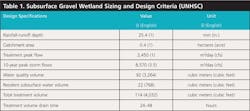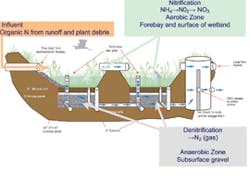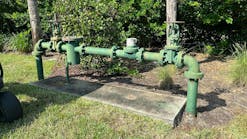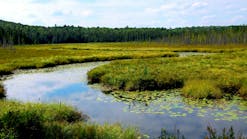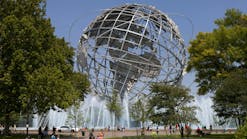Subsurface Gravel Wetlands for Stormwater Management
Subsurface gravel wetlands (SGWs) are an innovation in low-impact development (LID) stormwater design gaining significant recent attention. These horizontal flow systems take advantage of important biochemical nutrient cycling functions necessary for treating nonpoint-source pollution. SGWs approximate the look and function of natural wetlands, with high efficacy for removing sediments, nutrients, and other pollutants commonly found in runoff. They are not to be confused with constructed surface flow treatment wetlands, which are modifications of traditional ponds and include surface flow that is directed through a vegetated marsh system.
The SGW designed at the University of New Hampshire Stormwater Center (UNHSC) was based in part on descriptions by Claytor and Schueler (1996) and upon the idea of multiple-batch reactors commonly used in wastewater treatment. SGWs are designed as two cells in series with the primary flowpath being a permeable substrate consisting of a thick layer of gravel. The SGW surface is a vegetated wetland soil, allowing root growth and subsequent plant uptake. Stormwater, after entering the system at the hydraulic inlet, is directed down into the gravel layer below and subsequently filtered and treated as it flows horizontally through anaerobic zones from cell to cell. The capacity for subsurface treatment is a significant design advantage in that SGWs are relatively insulated from seasonal changes in performance. By combining biochemical removal and physical filtration processes, SGWs are a very effective LID option for advanced stormwater treatment.
A detailed study examining the long-term treatment functionality of SGWs was conducted at two installations in coastal New Hampshire, one located at the UNHSC in Durham and the other at Greenland Meadows, a retail development in Greenland, NH. The design at both sites subscribed to the UNHSC specifications. Specifically, investigations focused on determining water-quality functionality, long-term nutrient removal performance, and the capacity for mitigating the thermal impacts associated with stormwater.
Background
The UNHSC SGW was constructed in 2004 and has been constantly monitored through various experiments running through 2012. A detailed study of nutrient dynamics was performed from late 2007 through the summer of 2009, measuring phosphorous and nitrogen species at select locations in the influent, forebay, and wells within the subsurface gravel substrate, as well as in the effluent. The data collected were used to identify and evaluate nutrient removal characteristics, as well as the long-term and seasonal performance trends.
The SGW is constructed with a pretreatment sedimentation forebay where stormwater runoff enters the system. The broad shallow forebay design allows for settling of coarse particles and gross debris and provides for focused maintenance. Water then passes through a pipe into the wetland soil surface of the first of two subsurface gravel cells. Much as in a dry pond, water accumulates on the surface of the cell, where settling and aerobic transformations occur. Water then moves vertically into the gravel substrate through perforated standpipes. The flow subsequently moves horizontally through the gravel and exits the system through a drain. The gravel remains saturated at all times due to the design of an elevated outlet structure, with an invert located at an elevation just below the surface of the wetland soil. The constantly ponded gravel layer thereby creates anaerobic conditions, which are responsible for denitrification. Effluent flow leaving the system is controlled by a hydraulic outlet structure through orifice control. The SGW design specifications are available on the UNHSC website ( www.unh.edu/unhsc ).
The design characteristics for the UNHSC system are summarized in Table 1, and system components are illustrated in Figure 1. The wetland was planted with a combination of seeds and potted plants. The plants selected were native species chosen to provide a habitat function. The underlying soils of the system are marine clays with very low hydraulic conductivity, and as such, no liner was needed. However, in general, to maintain a layer of saturation in the gravel, the SGW needs to be constructed on low-permeability soils or with a liner.
From July 2007 through October 2010, water-quality monitoring for permit compliance was performed at the Greenland Meadows SGW. The development is a high-use commercial site with average annual daily traffic of more than 10,000. The wetland receives a majority of the site’s stormwater runoff prior to discharge into Pickering Brook, an impaired waterway. Sampling assessed background conditions in Pickering Brook, evaluated stormwater quality runoff from the site, and determined the resultant water quality of Pickering Brook downstream from the development.
Results
Long-Term and Seasonal Water-Quality Functionality at the UNHSC. Figure 2 illustrates seasonal and annual water-quality performance for the SGW at the UNHSC site for relation to nitrate, total phosphorus, total petroleum hydrocarbons (diesel range), zinc, and total suspended solids. Long-term monitoring data shows annual median nitrate removals of 75%, achieving 85% during the growing season (summer). In the winter, the removal rate dropped to 33%. Annual median orthophosphate removal was observed to be 75%, and total suspended solids removal was consistently greater than 95%. Five real-time water-quality parameters were measured in the influent and effluent, including temperature, pH, dissolved oxygen, specific conductivity, and turbidity.
EMC for each parameter is listed above.
The seasonality of nutrient removal is influenced by the plant growth cycle and by temperature. In the spring, as plants start to grow, nutrients are removed from the sediment and stored in plant material. In the fall, with the onset of colder weather, plants senesce and nutrients may be translocated back into root systems and rereleased to the environment. Eventually, the dead wetland plant biomass accumulates on the surface of the wetland as plant litter. Decaying litter then releases nutrients into stormwater when it passes through the system in the winter. The seasonality of plant growth is reflected in the increased nitrogen removal associated with the growing period, and a reduced performance during plant senescence and dormancy in the fall and winter. This would also reflect increased microbial activity during warmer temperatures. Periodically cutting and removing the aboveground plant material effectively removes some of the nutrient mass from the system and prevents it from being exported to receiving waters during non-growth seasons.
Another factor governing the seasonal removal of nitrogen is the seasonal change in water temperature and the associated change in dissolved oxygen concentrations. The mean temperature of runoff at the UNHSC site is 59°F during the warm season and 45°F in the cold season. Dissolved oxygen is closely correlated with temperature, with a mean of 7.8 milligrams per liter in the warm season and 10.2 milligrams per liter in the cold season. During the cold season, when more oxygen enters the SGW and lower microbial activity is occurring, the capacity of the system for developing the anaerobic conditions required for nitrate conversion is reduced.
Median annual orthophosphate removal has been 75%. It is suspected that removal is a result of the formation of insoluble phosphate complexes with iron and aluminum. No observed release of phosphorus during the winter when high chloride levels were present suggests that sorption capacity is regulated by the observed variations in ionic strength. As pH increases, phosphorus tends to form precipitates with calcium and magnesium carbonates, while under acidic conditions phosphorus binds to aluminum and iron oxides. The highest effluent phosphorus concentrations occur when the pH is between 5.5 and 6.
Nutrient Cycling and Removal Mechanisms. Nitrogen concentrations during the early to late portions of numerous sampled storms indicate a strong first-flush tendency: the majority of nitrogen washoff in the parking lots occurs with the first 0.3 inch of precipitation. Influent from the parking lot contains high concentrations of total nitrogen, which is the sum of particulate and dissolved nitrogen, and encompasses both organic and inorganic forms. Ammonia, nitrite, and nitrate were also present, although nitrite concentrations were low throughout the system, reflecting the rapid transformation of nitrite to nitrate. Typically this conversion occurs either on or before the surface of the first SGW cell.
In the SGW system, water moves from the forebay onto the surface of the first wetland cell, then into the subsurface gravel. Samples collected from the second wetland cell and from the effluent during the early part of storms exhibit a significant reduction in total nitrogen and very low levels of nitrate, suggesting that the nitrate has been successfully converted to nitrogen gas. Although nitrogen removal is most efficient early in the storm when the first-flush washoff mixes with the oxygen-depleted water already present in the system, this progression supports the hypothesis that the aerobic/anaerobic treatment system is supporting the full nitrogen transformation process. Oxygen measurements within the cells both during storms and between events confirm that anaerobic conditions are present in the substrate, with many measurements below 2 milligrams per liter and as low as 0.15 milligram per liter.
Transformation of organic nitrogen to gaseous N2O or N2 requires two phases: aerobic nitrogen transformation from organic to nitrate forms, and anaerobic reduction from nitrate to nitrogen gas. This process requires an aerobic environment followed by an anaerobic setting. Stormwater runoff entering the SGW cells is aerobic, but the subsurface cells are designed to remain saturated and isolated from surface oxygen. Microbial respiration uses available oxygen until the stored water is depleted and anaerobic conditions develop. The water-quality volume (WQV) in New Hampshire is 25.4 millimeters (1 inch) of precipitation in 24 hours (92% of daily precipitation is 25.4 millimeters [1 inch] or less). The resident water volume in the SGW subsurface gravel is approximately 5.8 millimeters (0.23 inch), or about one-quarter of the WQV. Because of the restrictive hydraulic control at the outlet, minimal mixing of the residual and influent water occurs, providing an interface between the fresh, nitrogen-laden influent and the oxygen-depleted resident water. This is important with respect to system sizing. More importantly, the resident water volume in the SGW closely approximates the first-flush volume for nitrogen.
In particular, improved forebay design is an important outcome from this study. Forebay design should prevent anaerobic conditions from developing, seek to provide treatment by settling, and maintain aerobic conditions with minimal maintenance. However, maintenance and removal of biomass is essential to prevent the rerelease of nitrogen and phosphorous and the development of anaerobic conditions from the accumulation of decaying organic matter. Shallow forebay design, while good for settling, requires potentially higher maintenance than other designs to prevent a thick mat of cattails and the subsequent development of anaerobic conditions. Improved designs would include a deeper pool of water in excess of 1 meter (3 feet), a deep sump catch basin or proprietary treatment device for removal of solids, or other designs that could maintain long-term aerobic conditions.
As was the case with nitrogen, higher phosphorus concentrations were found in the forebay for many, but not all, storms sampled during this study. Sources of phosphorus in the forebay are similar to those for nitrogen and include decaying plant material and resuspended sediments. It is interesting to note, however, that higher phosphorus and nitrogen concentrations in the forebay are not always consistent–on September 6, 2008, total nitrogen concentrations were higher in the forebay than in the influent, while concentrations of total phosphorus were lower in the forebay as compared to the influent. The amount of nutrients released in the forebay may be a function of several factors, including storm characteristics, seasonality, and recent maintenance or disturbance.
Hydraulic Performance. The long-term hydraulic performance of the system was strong. Table 2 illustrates the lag time and peak flow reduction characteristics observed over the period of monitoring. It is important to note that this system employs a hydraulic outlet control to throttle down outflow and create extended residence time (designed to drain the WQV in 24 hours). Median lag times were observed to be 251 minutes for an impervious area with a 19-minute time of concentration. Similarly, peak flow reduction was observed to be significant with a long-term median reduction of 87%. Very little seasonal variation was observed, indicating that cold-climate hydraulic functionality was very strong. Frozen soils or inlet structures were not observed to be a problem. In fact, far less impact due to freezing weather was observed than with conventional systems such as swales and ponds.
Greenland Meadows: Stormwater Quality Results. Long-term wet-weather flow monitoring established water-quality results for background conditions, during-construction activities, and post-construction performance of the SGW. During background sampling, which occurred over the span of seven months and three seasons, many laboratory analyses were returned below detection limits (BDL) for a variety of pollutants. Monitoring results over the course of site construction activities (four months and two seasons) indicated that measurable concentration increases in sediment, nitrogen, and phosphorus were observed. It should be noted, however, that the average concentrations of both nutrients were below any EPA action limits. Nutrient concentrations would be expected to be elevated during construction as this is a period of non-vegetation during which no plant uptake of nutrients is occurring.
Post-construction monitoring coincided with the opening of the large commercial store in summer 2009 and was conducted at the effluent from the gravel wetland and in Pickering Brook downstream of the zone of mixing of the gravel wetland outfall. Results indicate that effluent pollutant levels were typically at or below ambient stream concentrations across the range of contaminants.
The median TSS concentrations for the post-construction treated runoff (3 milligrams per liter TSS) were below preconstruction monitoring (5 milligrams per liter TSS), and significantly below the receiving waters of Pickering Brook (53 milligrams per liter TSS). The median TN concentrations for the post-construction treated runoff (0.50 milligram per liter TN) were below preconstruction monitoring (0.55 milligram per liter TN), and significantly below the receiving waters of Pickering Brook (1.35 milligrams per liter TN). The median TP concentrations for the post-construction treated runoff (0.005 milligram per liter TP) are below preconstruction monitoring (0.05 milligram per liter TP), and significantly below the receiving waters of Pickering Brook (0.145 milligram per liter TP).
Conclusions
The results of these studies indicate that SGWs are highly effective at treating stormwater runoff contaminants. In particular, nitrogen removal is high for a range of conditions, phosphorous removal is moderately effective, and seasonal variations are apparent for both nutrients.
Specifically, these studies found that:
- The SGW located at the Greenland Meadows site is delivering high-quality treatment for runoff originating from a high-contaminant-load commercial site and providing significant protection to the impaired receiving waters of Pickering Brook. In addition, the baseflow benefits, while not yet quantified, are observed to provide a nearly continuous source of cool clean baseflow from the site, discharging in a manner similar to shallow groundwater discharge.
- The first flush coincides with the optimal conditions for nitrogen removal, which occur early in the storm when anaerobic conditions are prevalent in the subsurface. Studies at the UNHSC have shown that the majority of nitrate mass washoff is within a first-flush volume nearly equal to the volume of resident water within the internal storage reservoir (~23% of the WQV) of the gravel wetland. This has important implications with respect to system sizing.
- The forebay to the gravel wetland, and probably all stormwater systems, may become a source of nutrients as the system ages. Sediments and plant debris stored in the forebay may be resuspended and released in subsequent storms. Routine maintenance is an important component in maintaining performance. The maintenance interval for which a decline in performance can be observed is three growing seasons, or at the end of the summer of the third year.
- Annual treatment is strong despite clear seasonal trends. The median removal efficiency measured at the UNHSC since 2004 for nitrate, the bioavailable form of nitrogen, is 75%. Removal is higher in the summer (>85%) than in the winter (>33%). This is most likely due to the combined effect of reduced uptake and microbial activity in the winter, coupled with organic nitrogen released from plant detritus in the fall and winter.
- Nitrate removal declined after three growing seasons with observed increase in the forebay indicating rerelease due to decomposition of organic matter. Treatment efficiency rebounded after harvesting of forebay vegetation.
- Phosphorus removal may be effected by pH, with lower removal occurring when the influent pH is between 5.5 and 6. Long-term performance for orthophosphate, the bioavailable form of phosphorus, shows an annual median removal rate of 75%. A decline in phosphorous removal related to maintenance was not observed.
- Forebay design is an important component of effective treatment. Forebay design should provide treatment by settling and maintain aerobic conditions with minimal maintenance. Shallow forebay design, while good for settling, requires potentially higher maintenance than other designs to prevent the development of a thick mat of cattails and anaerobic conditions. Improved designs would include a deeper pool of water in excess of a meter, or a deep sump catch basin or proprietary treatment device for removal of solids.

